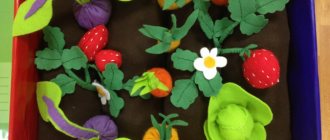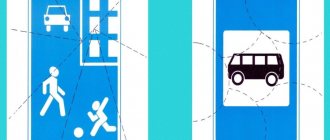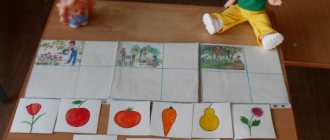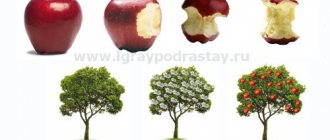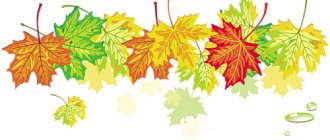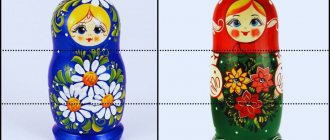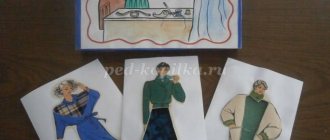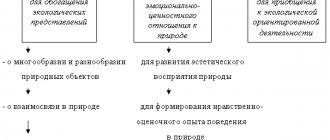Geometric puzzle games are very useful for developing children's spatial concepts, constructive thinking, logic, imagination and intelligence. One of these games is the ancient Chinese game TANGRAM. She was born in China 3000 years ago. From the 7 elements into which the square is divided, you can create many different objects and animal figures.
Tangram. History of origin.
This famous puzzle comes from China. According to legend, it was invented by the teachers of the emperor’s son - a mathematician, artist and philosopher. With the help of an exciting game, they taught the lazy heir calculations and combinatorial thinking. They taught us to comprehend the beauty of images and to understand the complex world through simple figures. The puzzle is a square of seven geometric shapes. By moving and arranging the figures, you can come up with more than 6 million compositions. In China it is called “chi-chao-tu”. Translated as “seven planks of skill” or “pattern of seven smart parts.” In Europe, tangrams were made from expensive wood and ivory. Many historical celebrities were fond of it, such as Napoleon Bonaparte, Thomas Hill, Lewis Carroll.
Before the advent of computers and various electronic games, tangram was popular along with chess and dominoes. Currently, tangram is more often used in children's educational institutions for the development of children.
Benefits for children
Despite its apparent primitiveness, tangrams are often called fitness for the brain - albeit not for adults, but for older kindergarten students and younger schoolchildren. As is often the case with educational games, the main and primary task of the tangram is to force the child to strain his thinking while solving some problem, because this is the only way to “pump up” mental abilities. In the meantime, tangram has a positive effect on the overall mindset and allows you to achieve the goal of developing the following skills.
- Ability to play by the rules . Probably the basic skill with which to begin learning tangram, and, perhaps, any games in general. Many modern children probably notice that any dissatisfaction provokes increased attention from their parents, a desire to please the crying person and calm him down. It is important for kids to learn that not all rules are set by their parents, and sometimes you need to give in to the demands of the rules.
Tangram game for preschoolers: goals and objectives
Tangram develops many abilities. One of the goals of the tangram is to teach children to independently find solutions. By putting the figures in one order or another, preschoolers try different options, choosing the optimal composition in accordance with the given rules. The magic square, like other logical tasks and puzzles, perfectly activates mental activity and develops character.
Tasks:
- To develop in children memory, attention, fine motor skills, various types of thinking (logical, spatial, imaginative, constructive), intelligence, imagination,
- To develop children's perception of color and shape,
- Teach to follow instructions and play according to given rules,
- To develop perseverance and patience as necessary qualities for the future school period,
- To instill in children responsibility and a serious attitude towards completing the assigned task.
Tangram material: wooden, magnetic, cardboard, plastic
Tangram can be made of different materials. The simplest option that can be easily made at home is a cardboard tangram. But, as you understand, it is also the most fragile.
An excellent solution would be to purchase or make a wooden tangram at home. Long-lasting, durable and eco-friendly, it's sure to be passed down from today's kids to their own.
It is very convenient to play with a magnetic tangram: you can create figures on a special field, where they will not move anywhere or overlap each other. It is quite easy to make it at home from special foam and magnets or a special magnetic tape (soft magnet).
Plastic tangrams are quite strong and durable. You can also make them yourself.
At what age do they play tangram?
There are many opinions, successful and unsuccessful experiences of teaching geometric puzzles to children of different ages. Often, preschoolers 2.5 years old do not yet understand the rules of the game. Children 3-4 years old are quite capable of moving and folding figures, but they do not always have enough perseverance. As a rule, it ends with 2-3 compositions under the guidance of a teacher or mother, then a switch of attention and types of activities is required. But the most diligent children of 3.5 - 4 years old can already come up with images themselves or assemble them according to existing patterns. And if you interest them not just in composing figures, but in making a multi-colored tangram, and organically interweave a fairy tale, a narrative with elements of adventure and vivid images during the lesson, then preschoolers can independently come up with unexpected solutions to the puzzle.
At what age does a child start playing tangram? Each teacher or parent decides for himself. Children may master it very early, or may not show interest even in older preschool age. The child should be ready for puzzles of this kind.
The teacher should take into account that if the activity involves making a tangram with their own hands, then the children must be able to work with scissors.
Cutting template
For ease of use, we will take the black and white version. It is convenient to print it or draw it yourself. It is better to do this on thick paper or cardboard. Then the square must be carefully cut along the lines.
To begin, ask your child to make a square out of these pieces. It is better if the child completes the task without looking at the drawing of the square. But if it doesn’t work out, then of course you can use the sample.
A variety of silhouettes are created from tangram elements. It is easier for a child to do this using samples with drawn components. Outline patterns are more difficult to reproduce.
Tangram: a fairy tale with tasks
The most interesting option for a lesson with a magic square for children would be an activity in the form of a fairy tale. You can choose any fairy tale in accordance with the age interests of preschoolers.
Take, for example, the cartoon “The Adventures of Luntik and His Friends.” All of his characters are well known to preschoolers. You can invite them to collect the image of the main character - Luntik, Baba Kapa, General Sher, Kuzya, Bee, Vupsen and Pupsen, the toad Klava and others.
As a rule, all children remember the beginning of the fairy tale: “Once upon a time, a baby was born on the Moon...”. Further, in accordance with the plot of the selected series, the heroes can meet in a flower meadow (collect a flower), play a ball (collect a ball), sit at the table and drink tea with pie (collect a table, then dishes, pie...).
In accordance with the age characteristics and interests of preschoolers, the teacher can complicate the lesson by introducing a competitive element: boys collect male characters - Luntik, Kuzya, the spider Shnyuk, and girls - female characters - Mila, Baba Kapa, butterflies, toad Klava, leech, etc. .
You can also watch one of your favorite cartoon series with the kids and together choose images of characters and objects to compose them from tangram figures.
When offering tangram tasks to children, it is important for the teacher to remind preschoolers to follow the rules of the game.
The tangram game perfectly develops intelligence, imagination, logical thinking, and teaches the basics of geometry. The tangram game is undoubtedly useful for preschoolers.
Buy on Aliexpress
Buy on Aliexpress
Buy on Aliexpress
If you found the information on the site useful, please share it on social networks:
Master class Tangram consultation in mathematics (preparatory group) on the topic
The game “Tangram” can be used in kindergarten, both in mathematics classes, and in free time during math quizzes and leisure activities, in individual work with children and at home, in the family. Children post pictures from dances and memorize vocabulary for them. At the same time, children develop and train their memory, the sounds assigned by the speech therapist are automated, and educational and correctional tasks are solved.
One of the components of the methodological support for the section “Elementary mathematical concepts in kindergarten” is the game “Tangram”, through which you can solve mathematical, speech and correctional problems.
The game “Tangram” is one of the simple mathematical games. The game is easy to make. A 10 by 10 cm square of cardboard or plastic, equally colored on both sides, is cut into 7 parts, which are called tans. The result is 2 large, 2 small and 1 medium triangles, a square and a parallelogram. Each child is given an envelope with 7 tanas and a sheet of cardboard on which they lay out a picture from the sample. Using all 7 tanas, tightly attaching them to one another, children create a lot of different images based on samples and according to their own ideas.
The game is interesting for both children and adults. Children are captivated by the result - they are involved in active practical activities to select a way to arrange the figures in order to create a silhouette.
The success of mastering the game in preschool age depends on the level of sensory development of children. While playing, children remember the names of geometric figures, their properties, distinctive features, examine the forms visually and tactile-motor, and freely move them in order to obtain a new figure. Children develop the ability to analyze simple images, identify geometric shapes in them and in surrounding objects, practically modify the figures by cutting them and composing them from parts.
At the first stage of mastering the game “Tangram,” a series of exercises are carried out aimed at developing children’s spatial concepts, elements of geometric imagination, and developing practical skills in composing new figures by joining one of them to another.
Children are offered different tasks: to compose figures according to a model, an oral task, or a plan. These exercises are preparatory to the second stage of mastering the game - composing figures using dissected patterns >.
To successfully recreate figures, you need the ability to visually analyze the shape of a planar figure and its parts. Children often make mistakes in connecting figures on the sides and in proportion.
So, the content of the work at the second stage of the development of games: this is teaching children to analyze a sample and verbally express the way to connect the spatial arrangement of parts.
This is followed by exercises in composing figures. In case of difficulties, children turn to the model. It is made in the form of a table on a sheet of paper of the same silhouette figure size as the sets of figures that children have. This makes it easier in the first lessons to analyze and check the reconstructed image with a sample.
The third stage of mastering the game is the compilation of figures according to patterns of a contour nature, undivided Appendix No. 1>. This is available to children 6-7 years old, subject to training. Games for composing figures using patterns are followed by exercises in composing images according to one’s own design.
The stages of work on introducing the game “Tangram” with children of senior preschool age were as follows.
At first, the “Tangram” game was played as part of a math lesson for 5-7 minutes. Observations of children during the game confirmed the fact that the children liked the game. After this, an element of competition was introduced, and the one who posted the picture faster than others received a reward-chip.
The children were even more interested in this. They began to ask for more time to play “Tangram”. This made it possible to conduct mathematical leisure activities, quizzes, where children played for up to 20-40 minutes.
To enrich the theme of the game, there was a need to diversify this material; it was found in the magazines “Elementary School”, “Preschool Education”, in the books of Z.A. Mikhailova, T.I. Tarabarina, N.V. Elkina. and etc.
Many pictures were developed by the teacher. A number of pictures were created by children from the preparatory group. Observations of children have confirmed that this game develops mental and speech abilities in children.
There were guys diagnosed with “general speech underdevelopment,” with poor memory, a small vocabulary, and withdrawn. They played alone more often. Teachers played with these children individually and offered pictures for the whole family to play at home. The results were unexpected, the children began to level out, some faster, some slower, but they no longer lagged behind their peers in posting pictures and were even ahead of some. Having overcome their shyness and reticence, these children began to quickly master the alphabet, reading, mathematics, and left kindergarten for school with clear speech, being able to read and count well.
The next stage in complicating this game was the selection of speech material for the pictures: riddles, funny short poems, tongue twisters, tongue twisters, counting rhymes, physical exercises. In a speech therapy kindergarten, this speech material has become especially useful for children with sound pronunciation and speech disorders. While playing “Tangram”, children memorized this material, reinforced and automated sounds in tongue twisters and tongue twisters. The children's speech was enriched and their memory was trained.
While playing “Tangram,” children’s quantitative skills were strengthened. (There are 5 triangles in total, 2 large triangles, 2 small triangles, 1 medium-sized triangle. There are 7 tans in the game in total).
Children practically mastered ordinal counting. So, if we count the tans of the “Rocket” picture from top to bottom, then the square is in fifth place, small triangles are in first and fourth place, the middle triangle is in third, large triangles are in sixth and seventh place >.
By counting tanas from top to bottom, from left to right, children practice orientation on a sheet of paper.
When composing this or that picture, children compare the size of the triangles, determine the place for small, large and medium triangles in the pictures of the game “Tangram”.
Children's knowledge of geometric shapes in this game (triangle, square and quadrangle) is constantly reinforced.
By playing and rearranging small cardboard figures, children train the small muscles of their hands and fingers.
In kindergarten speech therapy groups, work is carried out on lexical and grammatical topics, within the framework of which children’s knowledge about the world around them is clarified and consolidated. Pictures for the game “Tangram” have been developed on many topics (wild and domestic animals and birds, trees, houses, furniture, toys, dishes, transport, people, family, flowers, mushrooms, insects, fish, etc.). Pictures have been developed on the topic “Wild Animals”: hare, fox, wolf, bear, squirrel, lion, kangaroo >. By playing with pictures and laying them out, children learn a variety of speech material, and also reinforce and automate the sounds set by the speech therapist.
I bring to your attention speech material for the picture of a hare:
Pure sayings (automation of the sound “ch”):
Chu-chu-chu the bunny goes to the doctor, Cha-cha-cha the bunny sits at the doctor.
Tongue twisters (automation of the sound “z”):
Buba the bunny has a toothache.
Zoya's bunny's name is Zaznayka, and Zina's bunny's name is Know-It-All.
Zina is the bunny's mistress,
A bunny fell asleep in Zina's basket.
“Say the word”:
Trying to weave a cunning trail, I jumped through the snowdrifts... (hare)
- Oh! - the housewives shout around, - They got into the garden... (bunnies)
He rushes without looking back, only his heels sparkle. He rushes as fast as he can, his tail is shorter than his ear. Quickly guess who it is?.. (bunny)
Funny poems:
A bunny rides on a tram, A bunny rides, reasons: “If I bought a ticket, Who am I? Hare or not?
The hare says to the hare: “I wish I had a ravenous appetite!” “Appetite is of little use, I wish I had teeth like a wolf!”
The bunny is cold in the woods, let's knit the bunny's socks, covered an open field, and galloped off to another. He writes a phrase endlessly so that the fox does not read it right away.
Puzzles:
Both animals and birds offend him. He is afraid of every bush in the field, In winter he freezes so much under the Christmas tree, That in summer he does not take off his fur coat.
The scythe has no den, he does not need a hole, his legs save him from enemies, and his bark saves him from hunger.
Who jumps deftly and loves carrots, spoils the garden beds, and runs away without looking back?!
Not a lamb or a cat, wears a fur coat all year round. The fur coat is gray for summer, and a different color for winter.
A ball of fluff, a long ear, jumps smartly, loves carrots.
Fizminutka:
One, two, three, four, five The little bunny began to jump, The little bunny was good at jumping, he jumped 10 times. (jumping in one place and moving forward)
Counting tables:
One, two, three, four, five, there is no place for a bunny to jump, A wolf, a wolf walks everywhere; he clicks his teeth, clicks! And we are hiding in the bushes, hide, little bunny, and you too! You, wolf, wait until we hide - go!
The little cowardly bunny ran across the field, ran into the garden - found a cabbage, found a carrot, sits, gnaws. The owner is coming!
A hare runs across the bridge, long ears, short tail. Don't run too far, help us count. One, two, three - come out!
After posting a picture of an animal to reinforce the material on the topic, you can offer children the following speech games and tasks:
- “Name other animals”
- “Call it affectionately” (an object or its parts - a fox, a bear, a head, an ear, a tail)
- “Count to 5” (1 little fox, 2 little foxes, 5 little foxes)
- “Name the action words” (What does the fox do? Runs, sits, meanders, cheats)
- “1 and many” (fox - foxes, bear cub - cubs, ear - ears)
- "Who is absent?" (Bears, hares, kangaroos, wolf cubs)
- “Name the words-signs” (What kind of puppy? – kind, affectionate, trusting)
- “One of 2 words” (the hare has fast legs - fleet-footed)
- “Say the opposite” (selection of antonym words: brave - cowardly, kind - evil)
- “Name it, whose, whose, whose?” (Working with possessive adjectives - fox tail, bear ear, harelip, wolf tracks)
While talking about the picture, children practice agreeing an adjective with a noun in gender, number and case; in the use of comparative and superlative adjectives (one object is wide, another is wider, the third is the widest).
Children make up simple and complex sentences; you can even make up a story about your actions when posting a particular picture.
The speech material for the pictures for the game “Tangram” was selected so that the riddles, poems, tongue twisters were short, funny, to the point, interesting, so that they were easily perceived and remembered by children, so that the children received emotional release and relaxation.
We offer an approximate summary of leisure time in mathematics in the senior group with children with general speech underdevelopment.
Topic: “Development of speech in a mathematics lesson using riddles, tongue twisters, tongue twisters, short poems in the game “Tangram”.
Goal: combine laying out pictures of geometric shapes (tans) with speech material (poems, riddles, tongue twisters, tongue twisters, “say the word”, physical exercises with fingers).
Educational objectives:
- teach children to lay out a contour picture (a picture of a bunny, undivided into 7 geometric shapes, 7 tans);
- continue to teach children orientation on a sheet of squared paper;
- consolidate knowledge of geometric figures, days of the week in order, counting from 5 to 10, from 7 to 10, from 4 to 1, from 6 to 1;
- consolidate speech material on the topic “Animals”;
- develop children's memory.
Corrective tasks:
- learn to clearly pronounce tongue twisters, phrases, speech material from physical exercises with fingers, correctly agree adjectives with nouns (what kind of Christmas tree?), nouns with verbs (what is the bunny doing?), learn to form words with two roots (the hare has long ears - long-eared, cross-eyed , short-tailed);
- develop logical thinking in children;
- automate the sounds assigned by the speech therapist in children’s speech (“z”, “r”, “s”, “sh”);
- develop small finger muscles by working with Tangram and in the game “Find out by touch” (numbers made from sandpaper are used).
Educational tasks:
- cultivate attention, memory, endurance, perseverance, and the ability to complete the work started;
- cultivate accuracy in work;
- cultivate a desire to come to the aid of a friend.
Preliminary work:
- Together with the children, cutting out squares from paper and cardboard.
- Laying out the simplest figures and pictures by superimposing tans on the image.
- Incorporating the game “Tangram” into a math lesson (5-7 minutes).
- Individual work in free time in a group and homework for parents to play with the whole family.
- Familiarization and memorization of speech material for pictures, using it in the game “Tangram”, in consolidating the given sounds.
Material:
Handout: envelopes with tans, pictures from the game “Tangram”, sheet, checkered notebook, pen; ball, stickers for each child.
Demonstration: “Wonderful bag” with numbers made from sandpaper, pictures from the game “Tangram”.
PROGRESS OF THE CLASS
The topic of the lesson is announced and “Warm-up for the mind” is offered in a circle with a ball. (The teacher throws the ball to the child, asks a question. The child answers and throws the ball to the teacher).
Questions:
- Count further – 5 (the child counts: “6, 7, 8...”)
- Count further - 7 (8, 9, 10)
- Count back – 4 (3, 2, 1)
- Count back – 6 (5, 4, 3, 2, 1)
- Name the days of the week in order
- Name the neighbors of the number 5
- Name the neighbors of the number 7
- Name Tuesday's neighbors, etc.
Offer to sit at the tables. Work in notebooks.
- Task “Draw from a point” (without lifting your pen on the squared paper under the dictation of the teacher: draw 2 cells up, one to the right, 2 up, 1 to the right, 4 cells down, children draw an image). If the children completed the task correctly, then the result should be a bunny >.
Who did we draw? Bunny (check with the guys, praise).
- Physical exercise. The child pronounces words from physical exercises, children jump in place and with progress.
“1, 2, 3, 4, 5 - the little bunny began to jump,
- The bunny is good at jumping, (The words are accompanied by jumping on the spot)
He jumped 10 times.” (Jumping while moving in a circle)
- Suggest recalling a simple saying (to reinforce the sound “h”):
- Chu-chu-chu the bunny goes to the doctor, - Cha-cha-cha the bunny sits at the doctor.
- Exercise. “Let’s make one new word out of two” - a hare has long ears - long-eared, slanted eyes - cross-eyed, short tail - short-tailed, etc.
Game “Tangram”
The teacher asks questions:
— What did we cut out the parts for this game from? - From the square. - Let's make a square out of tans >. — How many sides, vertices, corners does a square have? - Four each. — How many tans are there in the game “Tangram”? - Seven. - Remember the riddle-poem about a square. - I am neither an oval nor a circle, - I am not a friend to the triangle, - I am a brother to the rectangle, - And my name is... (square).
In this case, you need to ensure that children clearly pronounce the sound “r”.
II. The teacher shows the children a picture that they together made from the drawings of the game “Tangram” and composed a fairy tale about the girl Masha. Appendix No. 2>.
They remember the fairy tale about Masha, and the teacher offers the following tasks, based on the content of the fairy tale.
- Finger gymnastics. Children use their index and middle fingers to “run” back and forth on the table. They imitate how Masha ran along the path.
- Exercise. Remember the riddles about the Christmas tree:
“Winter and summer in one color.”
“What kind of girl is this, not a seamstress, not a craftswoman.
She doesn’t sew anything herself, but wears needles all year round,” etc.
- Exercise. Lay out the Christmas trees from the tans: one row of children is the lowest, another row is the highest, the third is a medium-height Christmas tree. Appendix No. 2>.
- Exercise. Talk about joint actions: “I laid out the tallest Christmas tree, and Sasha laid out the lowest.”
- Exercise. Come up with words-signs about the Christmas tree. What Christmas tree? (Tall, short, fluffy, green, etc.).
- Exercise. Place a running bunny (undivided) on the flanograph.
- Exercise. Remember the funny rhyme and tongue twister about the hare:
A bunny is riding on a tram, A bunny is riding, talking! If I bought a ticket, Who am I, a hare or not? (Rhyme)
Zina's bunny is called Zaznaika, and Zoya's bunny is called Know-It-All (tongue twister)
Make sure that children pronounce the sound “z” clearly.
- Come up with action words about the bunny.
— What did the bunny do in the fairy tale about Masha?
- Sat, got scared, ran away, hid, cowarded, galloped, stood, ate, trembled (dictionary of verbs).
In a fairy tale, the girl Masha found a magic flower. Do some physical exercise with your fingers about a flower. Conducted by a child. Children perform movements with their fingers and palms.
Our scarlet flowers open their petals, The breeze breathes slightly, the petals sway, Our delicate flowers close their petals, Quietly fall asleep, shake their heads.
- Masha found herself in the house, and there was a wonderful bag there, let's see what's in the bag? (Numbers made from sandpaper)
The game “Find out the number by touch” is played.
The teacher, together with the children, analyzes their work, encourages them and gives out prizes.
Similar activities, leisure activities, and quizzes can be developed and conducted with children using other pictures from the “Tangram” game.
